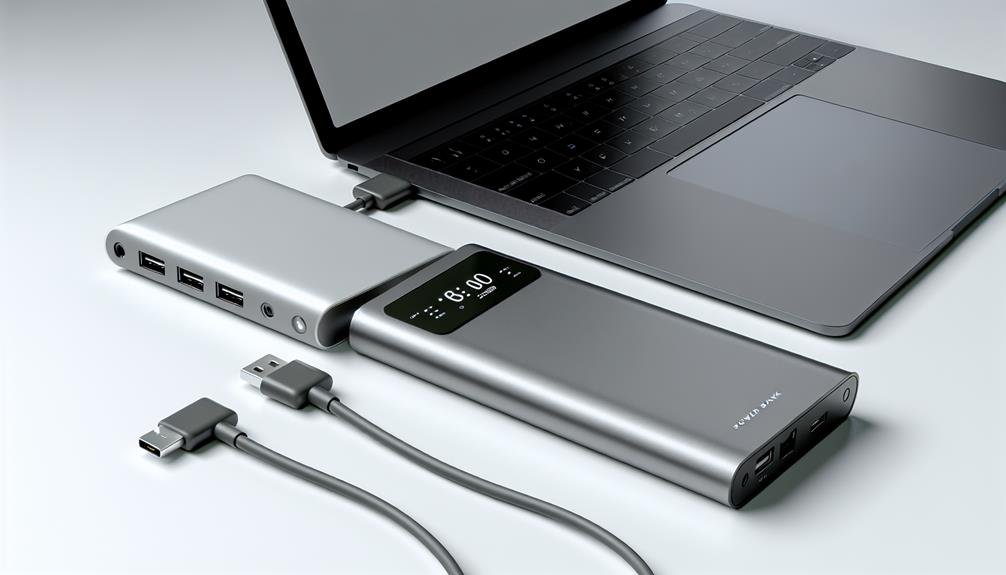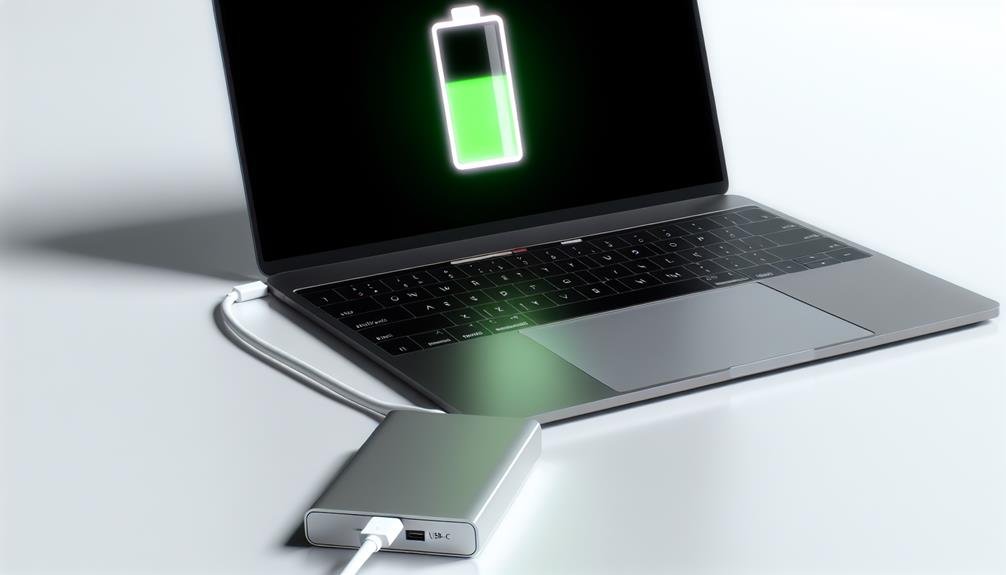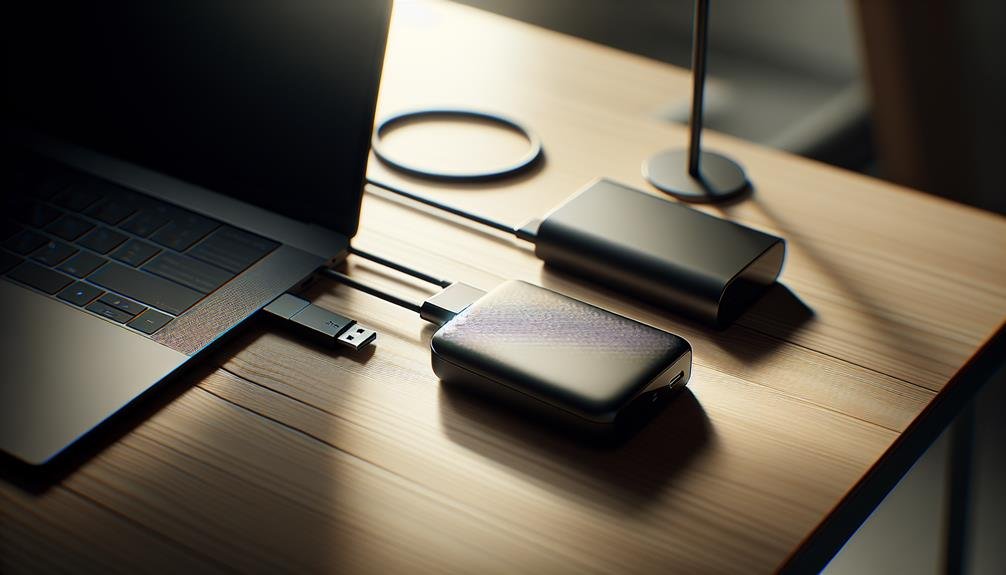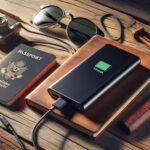To charge your laptop with a power bank, first, confirm the power bank has a substantial capacity (around 20,000 mAh) and USB-C ports. Check your laptop's voltage and wattage requirements against the power bank's output. Use a high-grade cable that fits both devices. Securely connect the cable to avoid interruptions. Monitor the battery levels and power bank status to prevent overheating. For peak performance, keep your battery between 20% and 80%, and manage your power consumption wisely. There are additional steps to master this setup and optimize your laptop remains charged and ready.
Choose the Right Power Bank

When charging your laptop with a power bank, choosing one that matches your device's power requirements is fundamental. Making sure your laptop receives the correct amount of power is vital for both efficiency and safety. Begin by examining the power bank capacity, typically measured in milliampere-hours (mAh) or watt-hours (Wh). For laptops, you'll need a power bank with a higher capacity, usually around 20,000 mAh or more, to guarantee it can provide ample charge.
Subsequently, evaluate the charging port options provided by the power bank. Many contemporary power banks come with USB-C ports, which are perfect for charging laptops. USB-C ports can supply higher power levels, making them suitable for more power-hungry devices like laptops. Moreover, some power banks offer multiple ports, allowing you to charge more than one device simultaneously. Nevertheless, ensure the power bank is compatible with the specific voltage and current your laptop demands.
Check Laptop Compatibility
Before connecting your laptop to a power bank, it is crucial to verify that your laptop's specifications match the power bank's output capabilities. Start by checking your laptop requirements, including the voltage and wattage needed for charging. Most laptops require a specific voltage (usually between 19V to 20V) and a certain wattage range for safe charging.
Next, examine the power bank capacity to confirm it can meet these requirements. Power banks come with different output ratings, and not all are suitable for laptops. Look for a power bank that specifically mentions compatibility with laptops. The power bank should have an output that matches or exceeds your laptop's requirements.
Charging safety is paramount, so make sure both devices support the same charging protocol. For example, if your laptop uses USB-C Power Delivery (PD), your power bank should support the same. Mismatched protocols can lead to compatibility issues and potential damage.
Gather Necessary Cables

To effectively charge your laptop with a power bank, you'll need to gather the appropriate cables that match both your laptop's and power bank's ports. Start by identifying the type of port on your laptop, such as USB-C, USB-A, or any proprietary charging port. Next, check your power bank's output ports to confirm they're compatible. If your power bank has multiple output options, choose the one that provides the highest charging efficiency for your laptop.
Cable organization is essential for maintaining a clutter-free workspace and ensuring you can quickly find the right cables when needed. Invest in cable organizers or ties to keep everything neat and prevent tangling. This not only improves charging efficiency but also extends the lifespan of your cables.
Safety precautions are crucial when dealing with electronic devices. Confirm your cables are in good condition with no visible wear or damage. Using damaged cables can pose risks like short circuits or overheating. Additionally, verify the power bank capacity matches your laptop's power requirements to avoid undercharging or straining the power bank.
Connect Your Devices
Once you've gathered the necessary cables, connect the power bank to your laptop by plugging the appropriate cable into both devices. Confirm the cable is securely attached to avoid any interruptions during charging. If your laptop doesn't start charging immediately, don't worry. Here are some troubleshooting tips and alternative methods to help you out.
- Check Connections: Sometimes, the solution is as simple as verifying all connections are properly aligned. Unplug and replug the cables to make sure they're firmly connected.
- Power Bank Compatibility: Validate that your power bank is compatible with your laptop. Some power banks may not provide enough power for certain laptops. Refer to your power bank's manual for compatibility information.
- Alternative Methods: If it still doesn't work, consider using a different cable or port. Some laptops have multiple charging ports, and switching ports can often solve the problem.
Safety is paramount, so be certain to use cables and power banks that meet the required standards. Avoid using damaged cables as they can pose a risk of electrical shock or fire. By following these steps, you'll guarantee a smooth and safe charging experience.
Monitor Charging Process

Once your devices are connected, keep an eye on your laptop's battery levels to confirm it's charging properly. Pay attention to the charging speed and make sure the power bank is providing consistent power. This helps you avoid any interruptions and guarantees your laptop is ready when you need it.
Check Battery Levels
Monitoring your laptop's battery levels while using a power bank guarantees you don't run out of juice unexpectedly. Keeping an eye on the battery guarantees that your laptop stays powered and helps you avoid potential issues. Here's how you can effectively monitor charging and troubleshoot issues:
- Check Battery Indicator: Most laptops have a built-in battery indicator. Make a habit of periodically checking this to see how much battery life you have left. This simple step can alert you to any disparities in charging.
- Use Battery Management Software: Many laptops come with battery management software. These tools can provide detailed insights into your battery's health and charging progress. They can also help you troubleshoot issues if your laptop isn't charging properly.
- Monitor Power Bank Status: Power banks usually have LED indicators to show remaining power. Regularly check these indicators to ensure your power bank has enough charge to continue powering your laptop. If the power bank is running low, you'll need to recharge it to maintain a steady power supply.
Observe Charging Speed
Paying attention to the charging rate of your laptop can prevent unexpected interruptions and secure efficient power management. Supervising the charging process guarantees that your laptop receives the necessary power without any hitches. Start by noting the charging effectiveness of your power bank. A power bank with higher capacity can charge your laptop more swiftly and effectively. However, be cautious; rapid charging can sometimes generate excess heat, leading to overheating risks.
Keep an eye on your laptop's temperature during charging. If it gets too warm, it could impact your battery life negatively. Overheating can cause lasting damage and reduce your battery's overall lifespan. It's essential to balance speed and safety.
Monitoring the charging rate also helps you understand how long your power bank will last. Higher-capacity power banks can handle more charging cycles, meaning you won't be caught off guard with a depleted power source. This careful observation allows you to manage your power bank capacity wisely, ensuring you're always prepared.
Ensure Power Consistency
To maintain your laptop's health and power efficiency, it's important to sustain a steady and consistent power supply while charging with a power bank. Keeping an eye on the charging process guarantees that your laptop receives the appropriate amount of power without any fluctuations that could harm its battery.
Here are three key steps to uphold power consistency:
- Check the Power Output: Confirm that your power bank's output matches your laptop's requirements. Using a power bank with insufficient or excessive power output can cause charging issues or even harm your laptop's battery.
- Monitor Voltage Stability: Voltage fluctuations can be harmful to your laptop. Use a power bank designed for laptops, as they often come with built-in safeguards to preserve voltage stability, safeguarding your device from spikes and dips.
- Use Quality Cables: The cable you use is crucial. Low-quality cables can result in irregular power delivery. Invest in a high-quality cable that supports your laptop's power requirements to maintain a steady and efficient charging process.
Optimize Battery Life
By adopting a few smart charging habits, you can extend your laptop's battery life to a great extent. Proper battery maintenance and managing power consumption are key. Always avoid letting your battery drain completely. Instead, keep it between 20% and 80% charged. This practice helps preserve the battery's lifespan.
Focusing on energy efficiency is also vital. Lower your screen brightness, close unused applications, and disable Wi-Fi if you don't need it. These small adjustments can notably reduce power consumption, making your laptop battery last longer.
Here's a quick reference table to help you optimize your charging habits:
| Tip | Description |
|---|---|
| Charge within 20%-80% | Avoid full discharges and overcharging to extend battery health. |
| Lower screen brightness | Reduces the energy your screen consumes. |
| Close unused applications | Frees up system resources and decreases power draw. |
| Disable unnecessary features | Turn off Wi-Fi and Bluetooth when not in use. |
| Use power-saving mode | Activates settings that reduce energy consumption. |
Frequently Asked Questions
Can I Charge My Laptop With a Phone Power Bank?
You can charge your laptop with a phone power bank, but check power bank compatibility and make sure it meets your laptop's voltage requirements. Using an incompatible power bank could damage your device or pose a safety risk.
How Long Does It Take to Fully Charge a Laptop With a Power Bank?
On average, it takes 2-4 hours to fully charge a laptop with a power bank. Charging efficiency and power bank compatibility are important. Confirm your power bank's output matches your laptop's requirements for safe and effective charging.
Is It Safe to Use a Power Bank for Charging Laptops?
Yes, it's safe if you verify power bank compatibility with your laptop and follow safety precautions. Check the power bank's voltage and capacity match your laptop's requirements, and avoid overheating by using certified, high-quality products.
What Should I Do if My Laptop Doesn't Charge With the Power Bank?
Did you know 30% of laptops have compatibility issues with power banks? Start by checking your cables and ports. If it still won't charge, explore alternate charging methods or seek professional help for troubleshooting tips.
Can Charging With a Power Bank Damage My Laptop Battery?
Charging with a power bank shouldn't harm your laptop battery if you use a compatible one. However, frequent use could impact battery lifespan and charging efficiency over time. Always make sure both devices meet the necessary safety standards.



